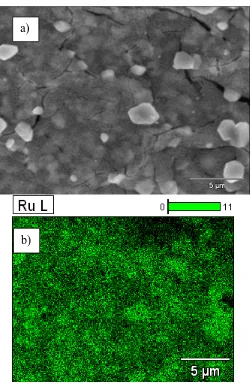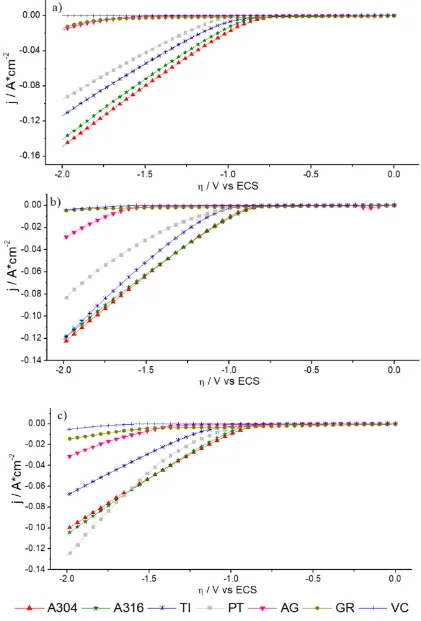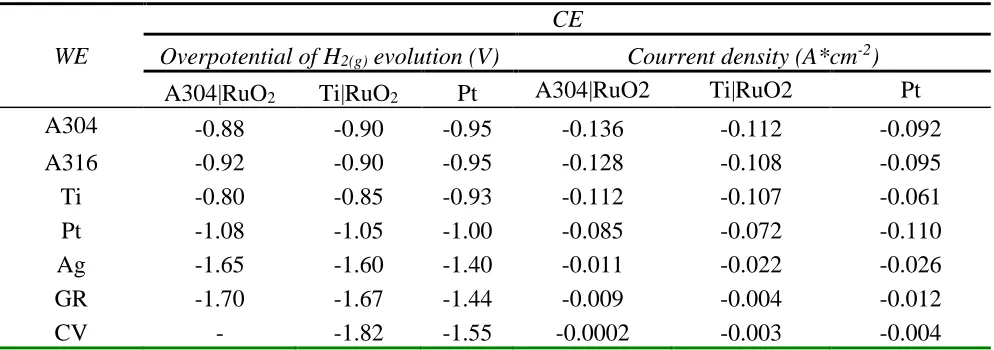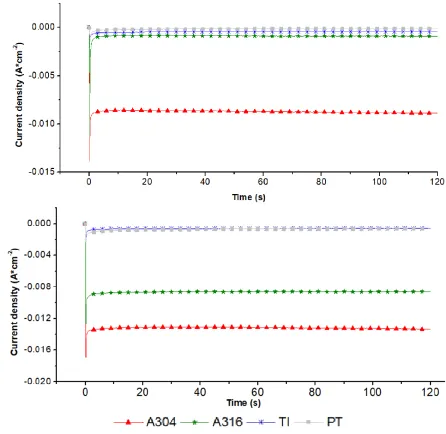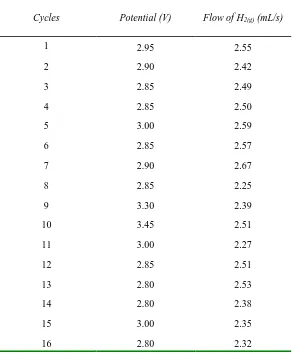Int. J. Electrochem. Sci., 13 (2018) 10873 – 10883, doi: 10.20964/2018.11.58
International Journal of
ELECTROCHEMICAL
SCIENCE
www.electrochemsci.orgEffect of DSA electrode (A304|RuO
2) on the electrochemical
production of H
2(g)M. A. González-López1, V. E. Reye-Cruz1,*, J. A. Cobos-Murcia2, M. A. Veloz-Rodríguez1, G. Urbano-Reyes1, M. Pérez-Labra1
1 Área Académica de Ciencias de la Tierra y Materiales, Universidad Autónoma del Estado de
Hidalgo, Carr. Pachuca-Tulancingo km 4.5 C.P.42184, Tel: 7172000 ext.2279, México.
2 Consejo Nacional de Ciencia y Tecnología, Depto. de Cátedras, Av. Insurgentes Sur 1582, Col.
Crédito constructor, Deleg. Benito Juárez, Ciudad de México, C.P 03940, México.
*E-mail: reyescruz16@yahoo.com.mx
Received: 4 June 2018 / Accepted: 2 August 2018 / Published: 1 October 2018
An electrochemical study was conducted to evaluate the behaviour of modified electrodes of the DSA type (dimensionally stable anodes) with the purpose of determining its viability to produce hydrogen (H2(g)) through the catalytic electrolysis of water. The DSA electrodes were manufactured with a sheet
of A304 stainless steel or Ti as the substrate, applying a coating of RuO2 by the modified Pechini
method. Also, different types of materials were tested as cathodes, including plates of titanium (Ti), silver (Ag), stainless steels A304 and A316, graphite rods (GR), glassy carbon (VC) and platinum (Pt). The results showed that the use of A304|RuO2 and Ti|RuO2 DSA electrodes allowed lower cathodic
potentials (≤ 1.0 V) for the start of the water reduction reaction to produce H2(g). The best arrangement
and electrode material for the catalytic production of H2(g) was a DSA electrode of A304|RuO2 and
A304 stainless steel plate as the cathode, which was even better than platinum, showing a high stability to modify their surface and structure. In conclusion, the use of a A304 stainless steel plate as a substrate instead of titanium to prepare DSA electrodes of A304/RuO2 for the catalytic production of
H2(g) is viable and inexpensive.
Keywords: DSA electrodes (A304/RuO2), Pechini method, Hydrogen generation, Electrocatalysts,
Electrolysis.
1. INTRODUCTION
important role in the development of this process [16, 17], the importance of the counter electrode used and its stability have not been considered. Modified electrodes of the DSA type (dimensionally stable anodes) have emerged as an alternative, with a high chemical and electrochemical stability. The chosen coating must allow the transport of an electric charge between the base metal and the electrode/electrolyte interface, as well as being able to catalyse the electrochemical reactions of interest [18]. These electrodes are characterised by an active coating, such as ruthenium, deposited on a metal substrate, such as Ti. DSA electrodes have been used for the oxidation of dyes [19], pesticides [20], tannery wastewater [21], and for the production of gases such as Cl2 and O2 [18, 22, 23]. These
electrodes are elaborated from a solution of a polymeric precursor by means of the Pechini method, which consists of the polymerisation of the metallic citrate with ethylene glycol and the chelation of the cations using citric acid [24]. This procedure makes it possible to obtain a homogeneous resin in which the ruthenium ions are completely and uniformly distributed in the matrix [25].
DSA electrodes have been used specifically for the production of oxygen [26, 27], but also function as counter electrodes in hydrogen production during the catalytic electrolysis of seawater, when a manganese oxide coating was used [26]. However, until now, the use of a substrate of A304 stainless steel plates with a RuO2 coating for use as DSA counter electrodes in an electrochemical cell
for hydrogen production has not been reported. Hence, the focus of this work was the preparation of modified electrodes (DSA) using plates of A304 stainless steel and Ti as a substrate, applying a RuO2 coating by a modified Pechini method, for use as anodes in the catalytic electrolysis of water. The surfaces of the modified electrodes were characterised using a scanning electron microscope equipment provided with an energy dispersive spectrometer (SEM/EDS), applying an analysis of elementary mapping. In addition, an electrochemical analysis was conducted to evaluate the behaviour of these electrodes together with different types of materials used as cathodes, with the purpose of determining its viability to produce hydrogen (H2(g)) in an electrochemical cell.
2. EXPERIMENTAL
2.1. Materials and preparation of electrodes
The electrodes used as cathodes in the electrochemical studies were titanium plates (Ti), silver (Ag), stainless steel A304 and A316, graphite bars (GR), glassy carbon (VC), platinum (Pt), while Pt and the modified DSA electrodes A304|RuO2 and Ti|RuO2 were used as anodes. The DSA electrodes
was prepared by pickling with concentrated hydrochloric acid and nitric acid, before rinsing with deionised water and drying in the muffle at 50°C. The steel substrate A304 was also applied by pickling, but with acid solutions of HCl and HNO3 to 20%. Subsequently, several layers of the
prepared ink were applied on the metal substrates (Ti and A304) until the desired coating was obtained. Finally, the coating applied on the substrate of the electrodes was sintered with a heating ramp at 5°C/min until reaching 500°C. The surface of the prepared electrodes was characterised superficially by scanning electron microscopy (SEM/EDS). The metallic electrodes of Ti, Ag, A304 and A316 used as cathodes were mechanically polished with sand paper of different grain sizes (220, 320 and 400). Later, these were placed in an ultrasonic bath in deionised water for 10 minutes, prior to use in the electrochemical cell. The electrodes of GR, VC and Pt were only polished with a cloth and rinsed with water. All the electrodes were air dried.
2.2. Electrochemical experiments
All experiments were conducted using a traditional three-electrode cell at room temperature (25°C). The working electrodes (WE) were plates of A304, A316, Ag and Ti, or Gr and VC bars and Pt wire, while the counter electrodes (CE) were the DSA prepared electrodes (A304|RuO2 and Ti|RuO2) and Pt wire. A saturated calomel electrode (SCE, E = 0.245 V vs. a standard hydrogen electrode) was used as the reference electrode in all experiments. The electrolytic solution used was prepared with 10 g/L of NaOH. Electrochemical studies were performed using a Princeton Applied Research 263A® potentiostat/galvanostat controlled by the Powersuite 3.0® software. Voltammetry
experiments were carried out in a potentials range of -2.0 to 0.0 V, initiated towards the cathodic direction at a sweep rate of 25 mV·s-1. In the chronoamperometry tests, the best arrangements
(WE-CE) were selected that showed lower cathodic potential values (≤ -1.0V) where the evolution reaction of H2(g) occurs with a high current density. In the chronopotentiometry tests, the best arrangement
(WE-CE) for H2(g) production was selected, using a commercial cell (type filter press) with 5 cathodes
and 4 anodes, in an electrolytic solution of 10 g/L NaOH. A power source was used to supply current to the electrolytic cell, registering the potentials (V) and flow of H2(g) produced (mL/s) during the
experiments.
3. RESULTS AND DISCUSSION
3.1. Characterisation of the surface of the DSA electrodes
Figures 1a and 1b show the images obtained by SEM of the DSA electrode surface of the Ti|RuO2 electrode. Figure 1a shows the coating on the surface of the plate that has a compact and
mapping by SEM/EDS of the RuO2 coating, where the Ru (highlighted in green) is homogeneous over
[image:4.596.175.426.115.499.2]the entire surface of the plate.
Figure 1. SEM/EDS images of the DSA electrode surface of Ti|RuO2 at 5000 x and 20 kV from: a) a
surface morphology analysis and b) an elemental mapping of Ru (in green colour).
a)
b)
Figure 2. SEM/EDS images of the DSA electrode surface of A304|RuO2 at 5000 x and 20 kV from: a) a surface morphology analysis and b) an elemental mapping of Ru (in green colour).
Figures 2a and 2b show the images obtained by SEM/EDS on the surface of the DSA electrode of A304|RuO2. A compact and fractured surface was also observed (Fig. 2a), while in elementary
mapping the Ru (highlighted in green) is homogeneous over the entire surface of the plate (Fig. 2b). These results indicate a good preparation of the DSA electrodes (Ti|RuO2 and A304|RuO2) was
achieved by this method, independently of the metal used as the substrate. Therefore, these electrodes were used in the further electrochemical experiments.
3.2. Cyclic voltammetry
The graphs in Figure 3 show the voltammograms obtained from the systems: a) A304|RuO2, b)
Ti|RuO2 and 3) Pt as CE, together with different materials (A304, A316, Ti, Pt, Ag, VC and GR) used as WE. The voltammograms show the potentials where an increase in the density of the cathodic current for each system begins. This increase can be quite informative, because it is related to the reactions that occur in the interface due to the nature of the solution and the electrodes [29]. In this case, it was related to the start of the evolution of H2(g) due to the reduction of the electrolytic medium.
It was observed that with the WE of Ag, VC and GR in the three systems: a) A304|RuO2, b) Ti|RuO2 and c) Pt, the increase of the cathodic current density is too low (Fig. 3 a, b and c, respectively), while for the systems where A304, A316, Ti and Pt were used as WE, the increase in cathodic current density is greater in the three systems (Fig. 3 a, b and c).
A more detailed analysis is presented in Table 1, where potential and current density (A*cm-2) data are shown for the beginning of H2(g) production evaluated in a potential of -1.9 V for all systems
studied. It was observed that when using Ti, A304 or A316 as the WE and CE of A304|RuO2, Ti|RuO2
or Pt, the values of the potential where H2(g) production began were less cathodic (between 0.80 V to
-0.95 V).
[image:6.596.86.507.75.696.2]
Table 1. Values of potentials and current density for the beginning of the evolution of H2(g) in the
systems studied, in an electrolyte medium of 10 g/L of NaOH
WE
CE
Overpotential of H2(g) evolution (V) Courrent density (A*cm-2)
A304|RuO2 Ti|RuO2 Pt A304|RuO2 Ti|RuO2 Pt
A304 -0.88 -0.90 -0.95 -0.136 -0.112 -0.092
A316 -0.92 -0.90 -0.95 -0.128 -0.108 -0.095
Ti -0.80 -0.85 -0.93 -0.112 -0.107 -0.061
Pt -1.08 -1.05 -1.00 -0.085 -0.072 -0.110
Ag -1.65 -1.60 -1.40 -0.011 -0.022 -0.026
GR -1.70 -1.67 -1.44 -0.009 -0.004 -0.012
CV - -1.82 -1.55 -0.0002 -0.003 -0.004
It was also noted that the systems with WE of A304, A316, Ti or Pt and CE of A304|RuO2,
Ti|RuO2 and Pt, present the highest values of current density (0.110 to 0.132 A*cm-2), associated with
a further evolution of H2(g). It is important to mention that in the case of Pt, it only reached high current
density values (j = -0.110 A*cm-2) when the WE-CE system was Pt-Pt, but even the density values of
current were lower than when CE of A304|RuO2 and Ti|RuO2 were used (j = -0.136 and -0.112 A*cm -2, respectively).
The results indicate that systems using DSA CE of A304|RuO2 and Ti|RuO2 or counter
electrode of Pt, with WE A304, A316 or Ti, can thermodynamically favour hydrogen production at potentials < 1.0 V. However, the system with the highest current densities employed the DSA counter electrode of A304|RuO2. Therefore, in order to validate this behaviour and determine the best CE-WE
arrangement, a chronoamperometry study was conducted in the system that showed the best performance for the beginning of the H2(g) evolution at potentials < 1.0 V.
3.3. Chronoamperometry
Figure 4 shows the potentiostatic transients obtained by chronoamperometry for the arrangements where a DSA CE of A304|RuO2 and WE of A304, A316, Ti or Pt (last was used for
comparative purposes) were employed, in an electrolytic medium of 10 g/L NaOH. The value of the potential applied to the working electrode was -0.9 V (Fig. 4a) and -0.95 V (Fig. 4b) for 120 seconds, just after where the increase of the cathodic current was observed in these systems (see Fig. 3a and Table 1). This analysis shows that at potentials of -0.9 V (Fig. 4a), only the arrangement using the DSA CE of A304|RuO2 and the WE A304 showed an increase in cathodic current density. The
comparison of the potentiostatic transients in Fig. 4b show that a higher cathodic current density is again observed for the arrangement where the DSA CE of A304|RuO2 and WE of A304 (0.0125
[image:7.596.51.548.111.286.2]
is important due to the fact that an arrangement (CE-WE) that uses the least amount of energy to carry out the H2(g) generation is also being sought.
The data corroborate the results obtained in the voltammetry study, indicating the possibility of the catalytic production of H2(g) at potentials <1.0 V using a DSA CE of A304|RuO2 and an A304 steel
WE. The chronopotentiometry study for the production of H2(g) is shown below, using an
electrochemical cell of filter press type with 5 cathodes and 4 anodes in an electrolytic solution of 10 g/L NaOH. A current of -0.0125 A*cm-2 was used, similar to that observed in the potentiostatic transient of the A304|RuO2 system and a WE of A304 (Fig. 4) at potentials of 0.95 V.
[image:8.596.70.516.243.677.2]
3.4. Chronopotentiometry
Table 2 shows the recorded average values of the potential and the flow of H2(g) (mL/s) by
imposing a current of -0.0125 A*cm-2 during 16 cycles of 1 hour of operation, in an electrochemical cell of a filter press type. The total electroactive area of the 5 cathodes of A304 was 800 cm2 and of the
[image:9.596.154.446.227.582.2]4 anodes of A304|RuO2 was 640 cm2.
Table 2. Average values of potential (V) and flow of H2(g) (mL/s) obtained in an electrochemical cell of
filter press type in a medium of 10 g/L of NaOH
Cycles Potential (V) Flow of H2(g) (mL/s)
1 2.95 2.55
2 2.90 2.42
3 2.85 2.49
4 2.85 2.50
5 3.00 2.59
6 2.85 2.57
7 2.90 2.67
8 2.85 2.25
9 3.30 2.39
10 3.45 2.51
11 3.00 2.27
12 2.85 2.51
13 2.80 2.53
14 2.80 2.38
15 3.00 2.35
16 2.80 2.32
The potentials registered in the electrochemical cell range between 2.8 V and 3.45 V, with an average value of 2.95 V, while the flow of H2(g) produced in the electrochemical cell was between 2.25
and 2.67 mL/s, with an average value of 2.46 mL/s, regardless of the value of the potential registered. These results indicate that the coatings of the prepared electrodes (DSA) are very stable, since the potential and flow of H2(g) produced were in a closed range. Furthermore, no large changes or
alterations in the surface of the electrodes are observed. Thus, taken together, these results established that the use of modified electrodes (DSA) of A304|RuO2 as anodes and cathodes of steel A304 allows
the catalysis of the electrolysis of water to produce H2(g) in a stable manner, without any degradation of
4. CONCLUSIONS
The modified counter electrodes (DSA) of A304|RuO2 and Ti|RuO2 make it possible to obtain
less cathodic potentials for the start of the generation of H2(g) in conjunction with the working
electrodes of A304, A316 and Ti, even in comparison to electrodes of Pt. The response obtained by the DSA electrode prepared with a stainless steel A304 substrate and RuO2 coating (A304|RuO2) showed
very similar behaviour to the DSA electrode of Ti (Ti|RuO2). Therefore, it was determined that it is
feasible to use this material as a substrate to manufacture DSA electrodes. The modification of the Pechini method, which consisted of changing the conditions of agitation and heating, allowed a better adherence of the coating to the surface of the substrates. It was determined that the arrangement that presented the best behaviour to produce H2(g) at potentials lower than 1.0V was a CE of A304|RuO2
and a WE of A304. Finally, the results show that the DSA electrodes of A304|RuO2, prepared by the
modified Pechini method, offer a stable surface and structure during the production of H2(g). Therefore,
it is feasible and economical to use A304 steel as a substrate instead of titanium to prepare the DSA electrodes of type A304/RuO2 and use them as counter electrodes in the mass production of H2(g).
ACKNOWLEDGMENTS
The authors would like acknowledges the economic support of National Council of Science and Technology for the doctoral fellowship and to the Cátedras CONACyT program.
References
1. G. A. N. Felton, A. K. Vannucci, J. Chen, L. T. Lockett, N. Okumura, B. J. Petro and D. L. Lichtenberger, J. Am. Chem. Soc., 129 (2007) 12521.
2. L. Jinlong, Y. Meng, L. Tongxiang, K. Suzuki and H. Miura, Chem. Phys. Lett., 678 (2017) 212. 3. B. M. Jovic, V. D. Jovic, G. Brankovic, M. Radovic and N. V. Krstajic, Electrochim. Acta, 224
(2017) 571.
4. C. Lamy, A. Devadas, M. Simoes and C. Coutanceau, Electrochim. Acta, 60 (2012) 112. 5. Y. M. Lin, and M. Rei, Catalysis Today, 67 (2001) 77.
6. V. Marinovic and R. Despic, Russian Journal of Electrochemistry, 40 (2004) 1155. 7. H. J. Choi and M. Kang, Int. J. Hydrogen Energy, 32 (2007) 3841.
8. S. Ahmed and M. Krumpelt, Int. J. Hydrogen Energy, 26 (2001) 291. 9. M. Momirlan and T. N. Veziroglu, Int. J. Hydrog. Energy, 30 (2005) 795. 10.H. J. Neef, Energy, 34 (2009) 327.
11.P. P. Edwards, V. L. Kuznetsov, W. I. F. David and N. P. Brandon, Energy Policy, 36 (2008) 4356. 12.P. C. Hallenbeck and J. R. Benemann, Int. J. Hydrogen Energy, 27 (2002) 1185.
13.M. Ni, D. Y. C. Leung, M. K. H. Leung and K. Sumathy, Fuel Processing Technology, 87 (2006) 461.
14.A. Steinfeld, Int. J. Hydrogen Energy,27 (2002) 611.
15.J. R. Bartels, M. B. Pate and N. K. Olson, Int. J. Hydrogen Energy,35(2010) 8371. 16.P. Sivasubramanian, R. P. Ramasamy, F. J. Freire, C. E. Holland and J. W. Weidner, Int. J.
Hydrogen Energy, 32 (2007) 463.
17.D. Merki, S. Fierro, H. Vrubel and X. Hu, Chemical Science, 2 (2011) 1262. 18.C. Comminellis, G. P. Vercesi, J. Appl. Electrochem.,21 (1991) 335.
20.G. R. P. Malpass, D. W. Miwa, S. A. S. Machado, P. Olivi and A. J. Motheo, J. Hazard. Mater., 137 (2006) 565.
21.C. R. Costa, C. M. R. Botta, E. L. G. Espindola and P. Olivi, J. Hazard. Mater., 153 (2008) 616. 22.L. A. De Faria, J. F. C. Boodts and S. Trasatti, Electrochim. Acta, 42 (1997) 3525.
23.X. Chen and G. Chen, Electrochim. Acta, 50 (2005) 4155.
24.M. I. B. Bernardi, S. Cava, C. O. Paiva, E. R. Leite, C. A. Paskocimas and E. Longo, J. Eur. Ceram. Soc.,22 (2002) 2911.
25.M. I. B. Bernardi, L. E. Soledade, I. A. Santos, E. R. Leite, E. Longo, J. A. Varela, Thin Solid Films,405 (2002) 228.
26.J. E. Bennett, Int. J. Hydrogen Energy, 5 (1980) 401.
27.E. Endoh, H. Otouma, T. Morimoto and Y. Oda, Int. J. Hydrogen Energy, 12 (1987) 473. 28.R. Berenguer, Electrochim. Acta, 54 (2009) 5230.
